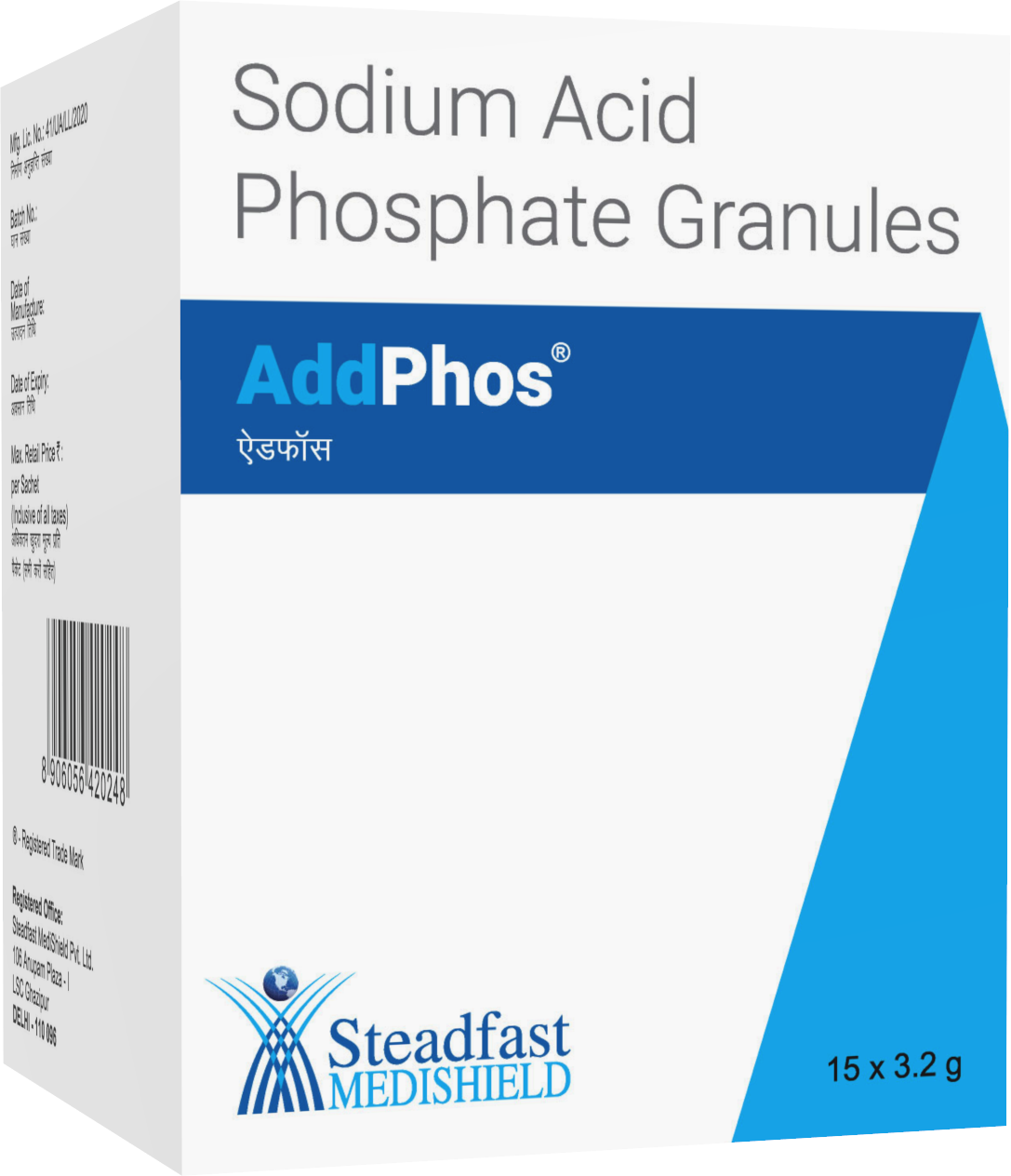
Description
Each AddPhos sachet contains 3.2 g of Sodium Acid Phosphate Granules. The sodium and phosphate content in each sachet is 20.4 mmol and 3.1 mmol respectively. Available as granules providing Phosphorus 500 mg equivalent to Phosphate 16.1 mol per sachet.
Pharmacology
Pharmacodynamics
Phosphorous is one of the most abundant elements in the human body — nearly 85% is present in the skeleton, with a balance in soft tissues and extracellular fluid. Most phosphorous are complexed as phosphate which is the body’s major intercellular anion and an essential component of cell membrane phospholipids, DNA and RNA. It is also critical to most biochemical processes including ATP synthesis and metabolic and enzymatic pathways. Phosphorous, as phosphate, also assists in maintaining normal physiological pH balance.
Phosphorous balance is regulated by several hormones including Parathyroid Hormone (PTH), which controls the release of phosphate from bones and inhibits renal reabsorption. Serum phosphate levels are inversely proportional to serum calcium levels and their physiological requirements are the same.
Mechanism of Action
Oral administration of inorganic phosphates produce a fall in serum calcium in patients with hypercalcemia. The sodium ions in AddPhos granules aid in the correction of the dehydration and sodium depletion, which is seen in hypercalcemia. In cases of hypercalcemia associated with impaired renal function and hypophosphatemia, the main effect of oral phosphate is to bind calcium in the gut and thus reduce calcium absorption.
Pharmacokinetics
Absorption & Distribution
Phosphates are mainly absorbed from the jejunum and duodenum by passive and active transport. Approximately two-thirds of ingested phosphate is absorbed from the gastrointestinal tract and most absorbed phosphate is filtered by the glomeruli and subsequently undergoes reabsorption. PTH and Vitamin D stimulate absorption of phosphate from the small intestine and its reabsorption from the proximal tubule.
Metabolism & Excretion
Virtually, all absorbed phosphates are excreted in the urine; the remainder being excreted in the faeces.
Indications
AddPhos Granules are used as an oral phosphate supplement in the treatment of the following conditions:
- Hypophosphatemia
- Hypercalcemia
- Phosphate depletion
- Calcium based kidney stone
Drugs which may lower phosphorus levels
- Antacids – Antacids with aluminum, calcium or magnesium can hamper phosphorus absorption in the digestive system.
- Anticonvulsants – Anticonvulsants such as phenobarbital and carbamazepine can lower levels of phosphorus in the body and create enzymes that hamper absorption.
- Bile Acid Sequestrants – Bile acid sequestrants used to lower cholesterol can prevent phosphorus being absorbed by the body.
- Corticosteroids – Corticosteroids such as prednisone or methylprednisone can increase the excretion of phosphorus in urine.
- Insulin – Insulin in high doses may lower phosphorus absorption.
- ACE inhibitors (BP medication) – Benazepril, Captopril, Enalapril and Lisinopril may lower levels of phosphorus.
- Cyclosporine – It may reduce the phosphorus absorption in the body.
- Heparin (Blood thinning)
- Non-steroidal Anti-Inflammatory drugs (Ibuprofen)
- Cardiac Glycosides (Digoxin)
Contraindications
AddPhos Granules are contraindicated in patients with a known hypersensitivity to sodium phosphate monobasic or any of the components of the granules.
Precautions
Considerations should be given to the sodium and potassium content of AddPhos Granules before administration to patients suffering from conditions associated with significant electrolyte imbalance or impaired renal function. In cases where restricted sodium intake is indicated, e.g., in the treatment of congestive cardiac failure, hypertension, pre-eclamptic toxemia, etc., the sodium and potassium content of AddPhos Granules should be taken into consideration.
Soft tissue calcification and nephrocalcinosis have been reported in isolated cases following intravenous therapy with phosphate. This is thought to be a function of dosage and rapidity of phosphate administration. While such effects appear less likely to occur following treatment with oral phosphates, careful surveillance of patients is recommended. The effect of oral phosphate on serum phosphate is likely to be minimal, but close monitoring of serum levels is recommended.
Use in Pregnancy:
The safety of AddPhos Granules in human pregnancy has not been formally studied.
Use in Lactation: The safety of AddPhos Granules in breastfeeding mothers and their infants has not been formally studied. However, both sodium and phosphate are found in human milk.
Use in the Elderly: As an excessive dosage has been reported to produce hypocalcaemia in isolated cases, particular care should be taken to ensure appropriate dosage in the elderly.
Interactions with other medicines: Concurrent administrations of AddPhos Granules with antacids containing agents such as aluminium hydroxide, calcium or magnesium salts, may result in the displacement of calcium from binding to oral phosphate and thus reducing the efficacy of this medication.
Parathyroid hormone (PTH) increases the urinary excretion of phosphate by blocking tubular reabsorption. The risk of ectopic calcification may be increased by concurrent use of calcium supplements. Vitamin D increases the gastrointestinal absorption of phosphates and therefore, increase the potential for Hyperphosphatemia.
Dosage and Administration
AddPhos Granules sachet should be emptied and dissolved in 2/3rd to 1 full glass of water. The dosage should be adjusted to suit the requirements of individual patients.
- Phosphate Depletion : Up to 3 g/d in 3 to 4 divided doses
- Hypophosphatemia : 2-3 g/d in 3 to 4 divided doses
- Hypercalcemia : 1-2 g/d
- Calcium Based Kidney Stone : 1-2 g/d
Estimated Phosphorus may vary with respect to weight of the patient.
Hypophosphatemia (Acute decrease); Estimated Phosphorus = 0.25 mmol / kg
Phosphate Depletion (Chronic); Estimated Phosphorus = 0.5 mmol / kg
Dosage As Per Body Weight
| Body Weight | Doses |
| 60 kg | 15 mmol every 6 hours with meals 1 sachet of AddPhos qid |
| 70 kg | 17.5 mmol every 6 hours with meals 1 sachet of AddPhos qid |
| 100 kg | Every 25 hours with meals 1.5 sachet of AddPhos qid |
As per the guidelines, the phosphorus level will increase by an average of 1.2 mg/dl with a dose of 0.25 mmol/ kg.
Over dosage
Excessive dosage has been reported to produce hypocalcaemia in isolated cases. This has proved reversible when dosage has been adjusted.
Presentation
3.2 gram of granules in sachet, 15 such sachets packed in a carton
